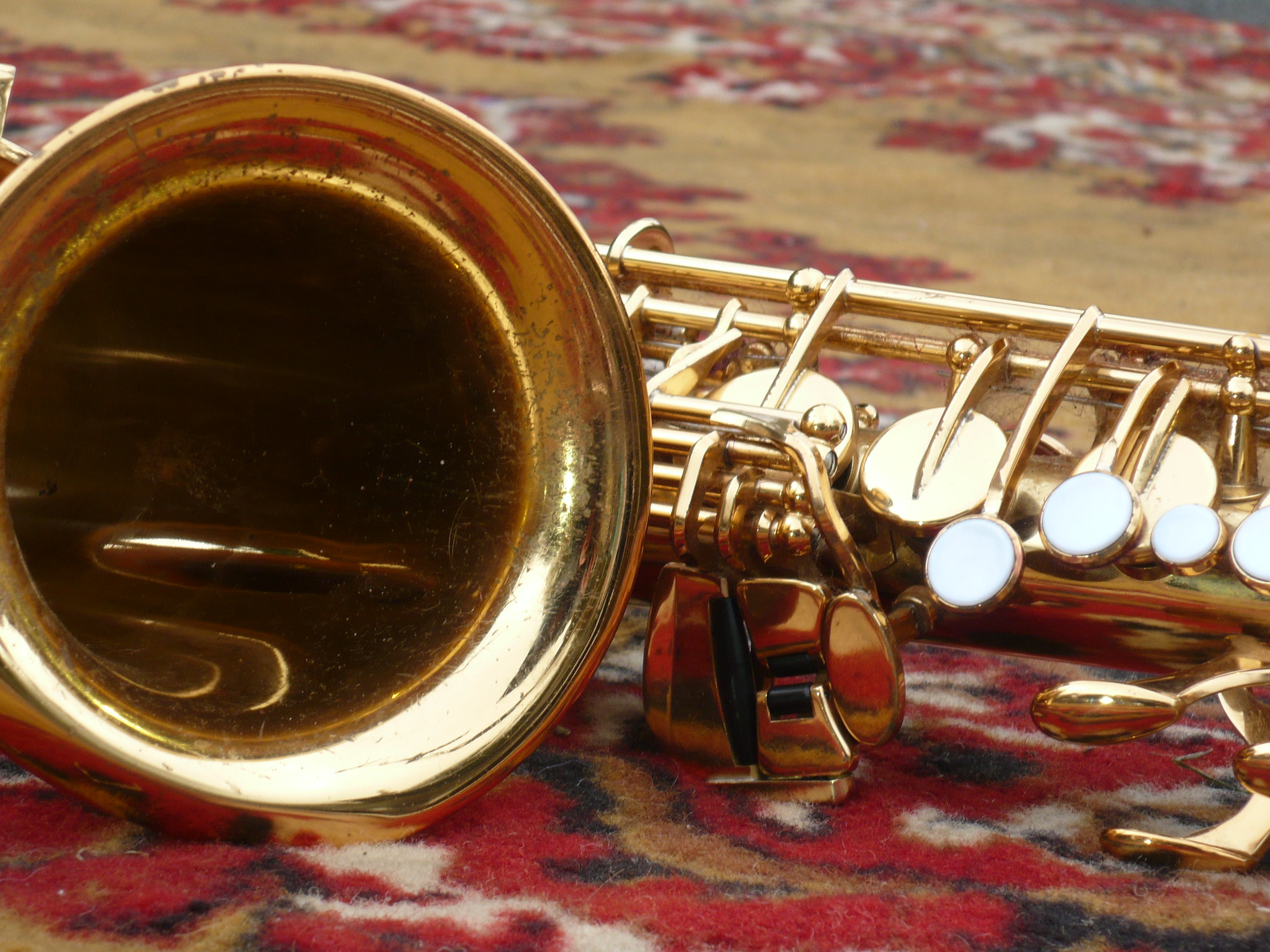What do trumpets, trombones, french horns, tubas, and even drums, all have in common with one another? They all have mutes that can be used with their instruments either by putting said mute on top of or inside of the instrument.
These mutes also serve a dual purpose: they can be used as a way to manipulate the sound of each instrument, like an FX pedal for guitars do, while also serving as a way to quiet down the drum, tuba, etc. And for most of the lifespan of the saxophone, this was something that it lacked entirely.
While maybe a bit odd from a surface view, there are a few very good reasons for this. In fact, there are exactly 26 reasons why a typical mute like the ones seen on other wind instruments isn’t viable.
In stark contrast to trombone, trumpet, and the other brass instruments that use mutes, the saxophone has 26 tone holes (including the bell opening) whereas the previously mentioned instruments only have 1. Each hole on the saxophone is just another place for the sound to escape, therefore if you were to make a normal mute that fit the bell of the saxophone, it would do practically nothing at all to the nature of the sound or its volume.
I can almost guarantee that when Adolphe Sax designed his first production saxophone in 1846, he never would have guessed that someone would think to design something specifically to overcome this problem.
Best DIY Sax Mute
Rather than jump right into the sax mute review, I figured that we should start with some of the options that were available to saxophonists for the decades prior to this new invention.
Back in the day, well before the explosion of sax products that we have now, any sax player who was living either in an apartment complex or was sharing a house with other roommates who didn’t particularly enjoy their practice sessions had to find some way to quiet themselves down.
The quickest and most accessible solution that many players have utilized for years has been a simple shirt or towel in the bell of the horn.
This method works mainly by minimizing the resonance of the sax rather than by actually stopping the airflow. This vibration dampening takes a lot of the high frequencies out of your sound, however, because you are essentially plugging up the bell of the horn this means that you often lose the use of the low Bb, B natural, and sometimes even a few more half steps.
While this won’t stop your roommates or neighbors from hearing you, this method will assuredly have them thanking you.
If you are lucky enough to have a walk-in-closet, this is also a good option and can effectively do the same thing as a towel in the bell since all of your clothes that surround you act as insulation, but instead doesn’t infringe on the saxophones low-end playability.
Non-Mute Options
If you don’t have the good fortune to have a walk-in closet or even any clothes to put in your bell, there are a few good alternatives that a saxophone player could use if they don’t want to draw their neighbors’ ire.
One such option, for instance, would be to just play in your car! If you have a truck with a camper shell, van, or especially an RV, practicing in a vehicle can be surprisingly perfect as a practice room.
The great thing about treating your automobile as a practice room is that you can practice anywhere! Your driveway, a parking lot, the Grand Canyon... You can go into the woodshed and practice your craft anywhere!
Another option would be a local college if they either don’t lock the practice room doors. Better yet, and more ethically, if you can work something out with the faculty where they let you practice there for free or a small fee, then you wouldn't have to worry about peeking over your shoulder, worried about getting kicked out!
New Sax Mutes
It really does seem like modern saxophonists have it made in the shade. The past few decades have seen some sizeable enhancements to the standard of living for each player; from synthetic reeds that last 100x as long as a normal reed, to new keys and attachments that make finger technique easier to master, it really isn’t surprising that someone would eventually make an actual saxophone mute that is fully functional.
e-Sax
Looking almost like a typical hard sax case, this mute is made up of two shell parts that are designed to fully enclose your saxophone, leaving only a hole for your mouthpiece to pole out from and two for your hands to go into.
The padding which they use on the inside is highly effective and brings your volume to a comparable whisper even when you are blowing full strength and best of all, they have designed the unit to include a mic built right into the side. This enables the player to plug in headphones and hear themselves as if they weren’t playing with the mute.
It also features a line-in system that lets you play along to CDs or other media, and most surprisingly, has a line-out feature that allows for actual live recording of your playing!
While the e-Sax is a bit pricey, between $499 and $599, considering you get a fully functional mute that has headphone, CD and media playback, as well as recording capabilities, I feel that you really do get enough bang for your buck to make it worth it.
Saxgourmet Saxophone Mute
This mute looks like a run-of-the-mill harmon mute that has been altered to fit into a saxophone, yet rather than make the sax sound tinny and metallic like a good harmon mute is supposed to, the people over at Saxgourmet claim that it is simply for quieting down the horn with minimal sound affectation.
Coming in at only $45, this is one of the cheapest options on this list (besides just using your shirt) and unfortunately it is too good to be true to my ear.
When researching this for this article, I came across an old video from when the company was just putting these out in the late 00’s. “Sweet”, I thought, “an actual video actually demonstrating the product.” However, after listening to it, it’s quite easy to tell that while the low-end harmonics of the instrument were obviously muted, the actual volume of the horn was barely being cut at all.
This boils down to one main issue essentially, the fact that the sax has so many other holes for air to vent out of before even reaching the end of the bell. Therefore, why would anyone make a device for the sax that just focuses on the old school idea of covering just the top of the bell and call it a day??
If you don’t believe me about its minimal effect, check out the video down below.
JazzLab Silencer
If you don’t want to put down $500 dollars for a full-on sax mute, but still want to get a great workout or warmup in, then the JazzLab would be the next best thing!
Meant to be used in tandem just with your mouthpiece, the Silencer fits right into the end and enables you to practice your long tones, scales, or anything else that you can think of, as loud and long as you want.
Electric Wind Instrument (EWI)
Finally, if neither of the previous options are for you... if the e-Sax is too heavy and cumbersome-looking and the Silencer isn’t enough of a full-body workout for you, then a good option for you might be an EWI.
EWIs are controller devices that, like electric keyboards, let the user play and alter midi files by using the same basic fingerings from a saxophone or clarinet.
The Akai EWI is the industry standard and has been used by the best musicians in the business for decades. They’re perfect for practicing at home because you plug the controller into your computer and either use the presets that it comes with or whatever midi files that you have, and then can get to work with nothing making sound except for the sound of your fingers taping onto the keys of the instrument.
In Summation
There are many more options available to saxophone players in just about every aspect of the sax and the development of an actual sax mute is no different. If you don’t want to spend any more money on your instrument, then you can just use your closet or a shirt/long sock in the bell. If you have some money in your bank account, however, then you can either choose to get an e-Sax mute, Jazz Lab Silencer, or an Akai EWI, and your neighbors will thank you greatly.







